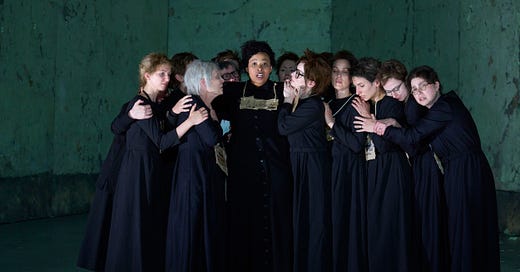From the Guillotine to Auschwitz
Barrie Kosky's stages Poulenc's opera at Glyndebourne with revelatory éclat
First night in prison: Golda Schultz (centre, Mme Lidoine) comforts the persecuted nuns Picture by Richard Hubert Smith
Over the past two decades Dialogues des Carmélites has emerged as one the great 20th century ensemble operas, but until this summer Glyndebourne had never tackled it. Conducted by Robin Ticciati and staged by the Australian director Barrie Kosky, Poulenc’s 1957 masterpiece emerged last weekend as one of the most gripping pieces of music theatre I have witnessed on the Sussex Downs in more than 40 years. Ticciati and his cast, but above all Kosky and his designer Katrin Lea Tag, deliver Dialogues des Carmélites as a vivid contemporary drama with time-travelling resonances: the designer’s opening scene costumes clearly set the opera during the 1790s Reign of Terror in France, but by the time the Carmelite nuns are incarcerated prior to their execution, Kosky and Tag reference the 1940s Nazi concentration camps.
This is no director’s whim. Although Poulenc based his libretto on a late 1940s play by French author Georges Bernanos, the original source was Gertrud Von Le Fort’s 1931 novel The Last to the Scaffold, an uncanny premonition of the Nazi terror. Over the past decade Kosky’s work at Berlin’s Komische Oper has revealed a fascination with works banned by the Nazis, and his linking of the fate of Von Le Fort’s Carmelite nuns to victims of the Nazi era could hardly be plainer.
Keep reading with a 7-day free trial
Subscribe to Operalogue to keep reading this post and get 7 days of free access to the full post archives.




